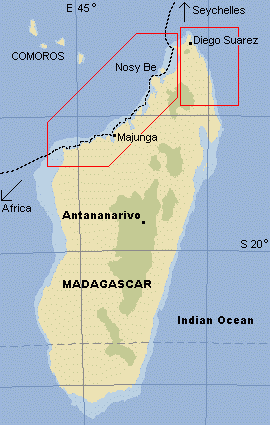
|
Indian Landfalls Madagascar Pages Related Pages |
Madagascar
Click on map to go to that area |
Languages: Malagasy (pronounced "MAL-gash") and French
Population: About 17 million in 50 ethnic groups and 12 major
tribes. An ancient mix of Asian (Indonesian), Arab and African. Most refer
to themselves as inhabitants of La Grande Ile (The Big Island), claiming that they are
not African. Features tend to bear this out.
Money: About 1,925 Ariary per US$1 in 2009. The now replaced
Madagascar Franc is still the currency base used in the markets and has a value
of about 5:1 to the Ariary. This can lead to some confusion when shopping if
they quote in Francs and you think they're talking about Ariary!
Landscape: Fourth largest island in the world. Rugged coastline,
with quiet waters in the west and wind-swept shores on the east. Mountainous (up
to 2,000m or 6,300ft) and dry interior except for remaining (and now protected)
rainforests mainly in the east. Limestone formations known as "tsingy" are a
unique feature. Home to lemurs and other astounding
flora and fauna.
Visited: Twice: 7 October to 3 November, 2007 and again August 3
to 17, 2009.
For those folks thinking of visiting Madagascar, we recommend the excellent Madagascar Travel Guide site.
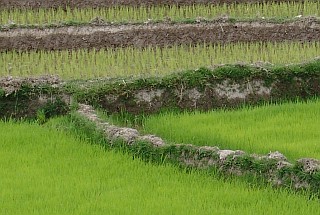 Early settlers from Indonesia introduced terraced rice cultivation to Madagascar |
History: In a nutshell, this is one big island with big drama in its history. But would history be without its excitement? The first settlers were probably sea-faring Indonesians, arriving about 2,000 years ago. They brought with them food-crops from Asia -- rice, in particular -- and established an agricultural-based civilization. Ethnic variety was spiced up by the arrival of sea-traders from Africa and Arabia. Things might have carried on peacefully except for the arrival of the Europeans, notably the Portuguese, under Diego Dias in 1500. For the next 200 years teams of British, Dutch and Portuguese tried to get a foothold on the island, but disease and angry natives kept them at bay. More successful were the unofficial visitors -- bands of pirates -- who made temporary bases on the small islands off the mainland from which they raided ships trying to round the Cape of Good Hope.
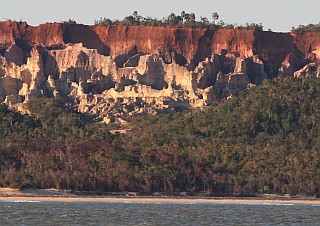 Ancient explorers talked of a great red island which they named Madagascar |
With the continued pressure of outsiders trying to horn in, the original Malagasy people formed into small kingdoms. In the west were the war-prone and more ethnically African Menabe peoples who eventually settled on the Sakalava river, giving rise to today's Sakalava tribe. In the east were the Betsimisaraka peoples unified under a half-caste (English pirate father and Malagasy princess) named Ratsimilaho. In central Madagascar the Merina people were under the rule of a man who desperately needed a nickname. Chief Andrianampoinimerinandriantsimitoviaminandriampanjaka (How's that for a name?!) sought the aid of European military advisors (who came with modern arms) and soon unified the central tribes into the most powerful of all Madagascar. Chief-with-the-long-name was succeeded by his son, Radama (the mother must have had it in for long names) in 1810 who ambitiously set out to bring all the tribes under his rule. War ensued, and Radama was successful with all but the Menabe (Sakalava) peoples of the north who preferred jumping off cliffs to surrender. No dummy, Radama waged war through marital vows, taking for his bride a Sakalava princess. With the country somewhat unified, Radama began diplomatic relations with the British, receiving aid and welcoming the London Missionary Society who converted many Malagasy to Christianity.
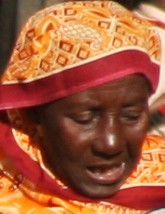 Malagasy woman |
Unfortunately, Radama died (or was quietly killed) at age 36 and one of his widows, a psychopath named Ranavalona, promptly reversed her late husband's policies. Christians who refused to abandon their faith within 3 days were hurled from cliffs, forced labor became the modis operandi, and eventually the woman, in her 33 years of rule, killed off about 25% of the population of Madagascar.
Ranavalona died in 1861 and as the country celebrated, a new leader, Radama II, came to power. Luckily for the ravished country, he was a fair-minded man who ended forced labor, allowed freedom of religion, and once again welcomed the Europeans: this time, the French, not the British. A year later a mysterious plague hit the capital of Antananarivo, killing thousands. The people said the ancestors (whom they still worshiped) sent the plague as revenge for bringing the Europeans back. Radama II was assassinated, and his rule was taken over by the assassin.
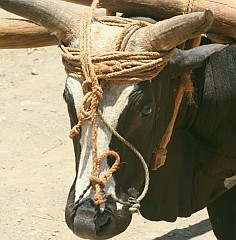 Both zebu & people under the yoke |
Years of confusion left a gap for the French to enter, with full military attacks upon the main ports. Marching on the capital, the British led a counter attack but the French prevailed. By 1895 Madagascar was a French protectorate (which is an interesting term for a country that's just been overrun!). The French abolished slavery replacing it with an almost equally repressive yoke of horrific taxation and expropriation of land by foreigners. During WWII the Vichy French (under Nazi Germany) ruled the land until the British took the port of Diego Suarez (on the NE coast) from where they fought the Vichy French and turned the rule over to the Free French. Struggles for independence in the late 1940's led to the deaths of perhaps 80,000 Malagasy. In 1958 Madagascar gained independence from France, but the foreigners were retained to run the economy and the military. The ensuing years saw coup after coup, assassinations, and inter-tribal battles for supremacy. French ex-patriots fled the country and by the late 1970's President Ratsiraka sought aid from the communist-bloc countries. Ratsiraka ruled for 17 years in a one-party, socialist state. In the early 90's the country erupted into strikes and riots that immobilized the capital and left the country in a state of confusion for 2 years. Democratic elections were held and Professor Albert Zafy came to power, ending Ratsiraka's rule. But Zafy was soon impeached for abuse of power and new elections were held. To great international surprise, Ratisraka was re-elected (by a close margin against, get this, Zafy!) and took office again in 1997. Four years later an entrepreneur (in the yogurt business) won a general election, but Ratsiraka claimed that HE won. Sound familiar? There were accusations, blockades, and martial law imposed until the High Court proclaimed Ratsiraka's opponent, Ravalomanana the winner. Ratisraka was exiled to France and sentenced in absentia to 10 years of hard labor.
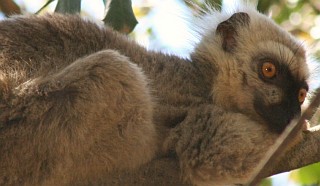 A male Sanford Lemur rests in the trees |
Today, Madagascar is striving to protect and improve its demolished environment, attract foreign aid, increase exports of minerals, and promote tourism. But, as one of the poorest countries in the world at a per capita income of about US$240 per year (about $1/workday) it has a way to go.
Ocelot's Overview: We had no preconceived notions about Madagascar -- except what we'd seen in the animated movie Madagascar. Which meant we were open to, well, whatever. Perhaps the biggest surprise was the lovely cruising grounds in and around Nosy Be. Flat waters, with alternating onshore/offshore breezes each day, and the glorious dhows sailing about!
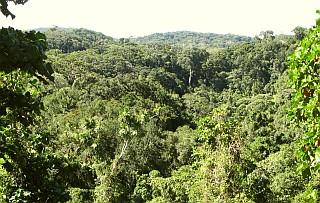 Dense, rugged mountains kept early tribes isolated on Madagascar |
Traveling inland (on our own, without a package tour) was quite a challenge.
Madagascar is about the poorest country we've visited on our travels around the
globe. As such, one might think that independent travel could be a pretty good
bargain, but the opposite was true. Because there are so few travelers
(foreign or otherwise) there is no infrastructure for them -- very few small
hotels or hostels and not much food choice between a few upscale restaurants and
the little roadside stands. Transport is certainly cheap (i.e. a few dollars for
many hours' in a taxi brousse -- jungle taxi), but the ride is
exhausting, with horrific road conditions, slow traffic, many stops, and cramped
seating. Basically, good old fashioned third world land travel. ![]()
Madagascar's landscapes of intricate red sandstone and limestone formations, high hills of red and green, the rainforest on Montagne d'Ambre, and the forests of Ankarana were all treats. But the best were the lemurs, chameleons, birdlife and other unique animals of this mini-continent off the coast of Africa.
Top Level: Home | Destinations | Cruising Info | Underwater | Boat Guests | Ocelot | Sue | Jon | Amanda | Chris | Site Map | Make a Comment
|
If our information is useful, you can help by making a donation |
Copyright © 2000‑ Contact: Jon and Sue Hacking -- HackingFamily.com, svOcelot.com. All rights reserved.